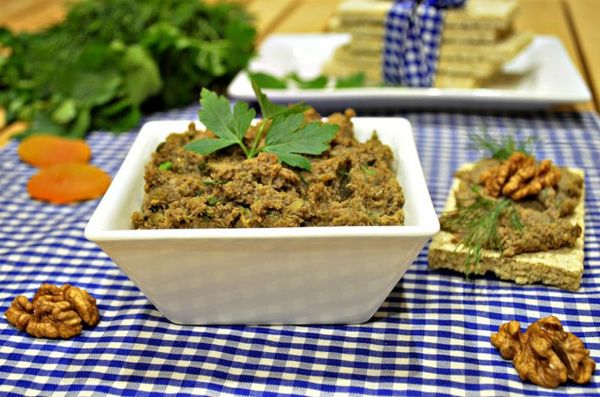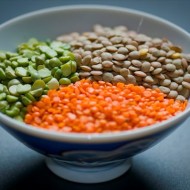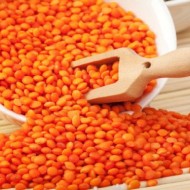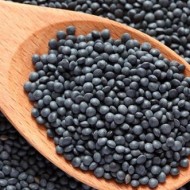What is lentil and how is it good for the body
Content
Brief description of the culture
Lentils are an annual food crop. The height of the bush ranges from 15 to 75 cm. Erect branched stems are covered with paired leaves, which end in a tendril. The leaf plates are oval, up to 2 cm long and 0.8 cm wide.

The plant blooms from June to July with small flowers (5-7 mm), collected in drooping inflorescences like a brush. Their color depends on the variety and can be white, pink or purple. The fruits are small flattened beans measuring 1x0.8 cm.
Video "The benefits and harms of lentils"
In this video, experts will talk about the benefits and dangers of lentils.
The main types and varieties of lentils
Depending on what the lentil grain looks like, the culture is divided according to two characteristics:
- By fruit size:
- large-seeded;
- small-seeded.
- By color:
- classic (green, red);
- specific (black, brown).
Black
The most expensive species, the grains of which resemble black eggs. Due to this similarity, the variety was named Beluga. During the flowering period, the bushes are covered with pink, almost purple inflorescences. The fruits are very small, smooth and shiny. Black lentils are powerful antioxidants and are rich in protein. Her homeland is Canada, but the culture is most popular in India.
Red
Often called pink or Egyptian. It belongs to small-seeded varieties and grows in Asian countries. The fruits of red lentils are light scarlet in color, small. Due to the lack of a shell, the beans cook very quickly and are used to make mashed potatoes or soups. Grain dishes are very nutritious and rich in useful microelements.
Green
Green lentils are a large-seeded species. The color ranges from greenish to dark green. Beans are valuable for their high amount of protein. Used in the preparation of salads, meat dishes, rice additives. For the first time, the plant began to be cultivated in France, and only then it got to the countries of Asia. However, the culture remains very popular with European chefs.
Yellow
Yellow lentils are peeled green fruits of the Aston, Laird, Richley varieties. The beans are large and taste like a nut. They have a high glycemic index (30 units). The culture is grown in many countries, but the people of India are especially fond of it. They cook the traditional national dish from beans - sambhar.
Brown
The most popular type of plant. The most famous variety is Pardina. It was developed in Spain and has a high fiber content. The fruits are covered with a brown shell of different shades, which is why lentils are also called variegated. The grains are hard, so they need to be soaked before cooking. These lentils are canned or made into soups.
Composition and calorie content
In addition to being a source of high amounts of plant protein, lentils also contain many other beneficial substances:
- tryptophan;
- amino acids;
- folic acid;
- fiber;
- trace elements: Ca, K, P, Fe, Mn, Cu, B, I, Zn;
- vitamins of group B, A, C, PP;
- fatty acids Omega-3, Omega-6.
The calorie content of 100 g of lentils is 175 kcal. This makes it a good source of energy replenishment.

One serving includes:
- proteins - 25 g;
- fats - 1 g;
- carbohydrates - 54 g;
- liquid - 14 g.
100 g of the product contains almost a daily requirement of folic acid.
Beneficial features
Lentils are the only crop that has not been genetically modified and is incapable of absorbing harmful substances. Due to the increased content of easily digestible vegetable protein, beans are very nutritious and also help the body fight disease.
The useful properties of the plant include:
- beneficial effect on the nervous system;
- maintaining blood sugar levels;
- improved bowel function;
- strengthening the heart muscle and vascular walls;
- slowing down the aging process;
- reducing the risk of malignant tumors.
Cooking applications
Lentils can be found in many cuisines around the world. Each dish has its own variety:
- salads and side dishes are prepared from varieties that do not boil over - brown, green;
- soups, mashed potatoes and stews are made from yellow lentils;
- Asian cuisine is based on red varieties;
- in India, black fruits are preferred.
Also, lentil flour and an unusual drink, somewhat similar to coffee, are made from the fruits of this legume culture.
How to boil lentils
Except for the brown variety, other types of beans are not soaked before cooking. For cooking, the lentils must be boiled beforehand. Cooking time depends on the variety:
- green - 25-40 minutes;
- brown - 30–35 minutes;
- red, yellow - 20-30 minutes.
For soups, it is better to take chopped beans, which are boiled for only 10-15 minutes.

Lentils must be pre-rinsed, selecting bad fruits. The beans should be poured with water at the rate of 1: 2, brought to a boil, add 1 tbsp. l. vegetable oil and leave to simmer over low heat, covered. It is better to add salt at the very end.
Sometimes you can use a multicooker for cooking. A microwave oven is an alternative. The cooking recipe is simple: pour 0.5 cups of beans into a container, pour boiling water, salt and cook for 7-10 minutes at the highest power.
Culinary ideas
Lentils are a product from which even “meat” dishes can be prepared. The most popular beans are among vegetarians.
Vegetarian dinner
Add washed beans to lightly fried garlic, onion, ginger root and curry. Season with turmeric, sugar and stir. Place diced vegetables - pumpkin, bell peppers, zucchini - into a saucepan. Pour in a little coconut milk broth.
After bringing to a boil, add the chopped tomato, stir and simmer until cooked. Serve with rice or as an independent dish, seasoned with coriander before serving.
Lentil meatballs
Add the onion passaged in vegetable oil to the boiled beans. Season with salt and pepper and mix well. Having formed small meatballs from the lentil mass, fry them in hot oil.
To prepare the sauce, fry the finely chopped onion, garlic, hot pepper. Add the diced courgettes and chopped peeled tomato to it.
Simmer vegetables over low heat until cooked. Meatballs seasoned with sauce are best served with coriander.
Fake pate
Add carrots, garlic, ginger root to the onion passaged in vegetable oil. Simmer for 10 minutes, and then add lentils with millet in a 3: 1 ratio. Fry over high heat for 2-3 minutes. Pour in 2.5 cups of vegetable broth, salt and simmer until the excess liquid evaporates.
When the vegetables are tender, cool them down and then add the grated ginger, chili and almonds, mixing everything with 2 raw eggs. Divide the resulting mass into tins and bake for 60 minutes at 180 ° C.

How to store lentils
Raw lentils are stored for 10 to 12 months. The storage location should be dry, dark, and the container should be made of cardboard or natural fabric. Do not expose beans to moisture, sprinkle in glass jars or plastic bags.
A boiled product can be kept in the refrigerator for no longer than 6 days, and a frozen product can be kept for six months (without defrosting).
Harm and contraindications of lentils
Lentils are useful products, but they are contraindicated in patients with gout, arthritis, or kidney failure. Even in healthy people, excessive consumption of beans can cause the following problems:
- bloating;
- constipation;
- joint diseases;
- diseases of the pancreas.
Lentils should never be given to pets, as the chemical composition of the beans can cause serious health problems and sometimes be fatal.
In conclusion, we note that lentils were already known to representatives of ancient civilizations. Bean dishes were often present on the tables of the nobility, and ancient healers used the plant in the treatment of many diseases.






